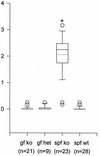Resident enteric bacteria are necessary for development of spontaneous colitis and immune system activation in interleukin-10-deficient mice
- PMID: 9784526
- PMCID: PMC108652
- DOI: 10.1128/IAI.66.11.5224-5231.1998
Resident enteric bacteria are necessary for development of spontaneous colitis and immune system activation in interleukin-10-deficient mice
Abstract
Mice with targeted deletion of the gene for interleukin-10 (IL-10) spontaneously develop enterocolitis when maintained in conventional conditions but develop only colitis when kept in specific-pathogen-free (SPF) environments. This study tested the hypothesis that enteric bacteria are necessary for the development of spontaneous colitis and immune system activation in IL-10-deficient mice. IL-10-deficient mice were maintained in either SPF conditions or germfree conditions or were populated with bacteria known to cause colitis in other rodent models. IL-10-deficient mice kept in SPF conditions developed colitis in all segments of the colon (cecum and proximal and distal colon). These mice exhibited immune system activation as evidenced by increased expression of CD44 on CD4(+) T cells; increased mesenteric lymph node cell numbers; and increased production of immunoglobulin A (IgA), IgG1, and IL-12 p40 from colon fragment cultures. Mice populated with bacterial strains, including Bacteroides vulgatus, known to induce colitis in other rodent models had minimal colitis. Germfree IL-10-deficient mice had no evidence of colitis or immune system activation. We conclude therefore that resident enteric bacteria are necessary for the development of spontaneous colitis and immune system activation in IL-10-deficient mice.
Figures






References
-
- Aruffo A, Stamenkovic I, Melnick M, Underhill C B, Seed B. CD44 is the principal cell surface receptor for hyaluronate. Cell. 1990;61:1303–1313. - PubMed
MeSH terms
Substances
LinkOut - more resources
Full Text Sources
Other Literature Sources
Medical
Research Materials
Miscellaneous

